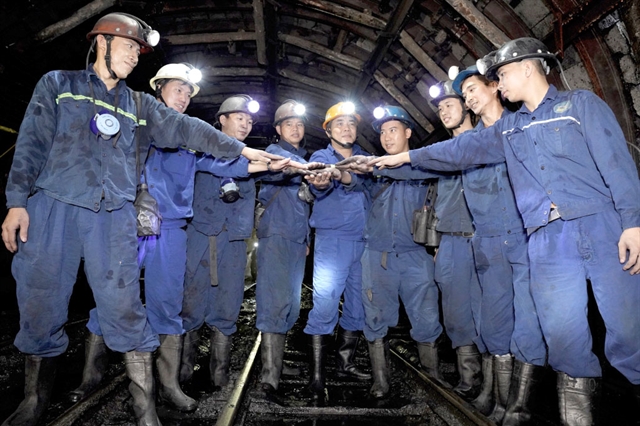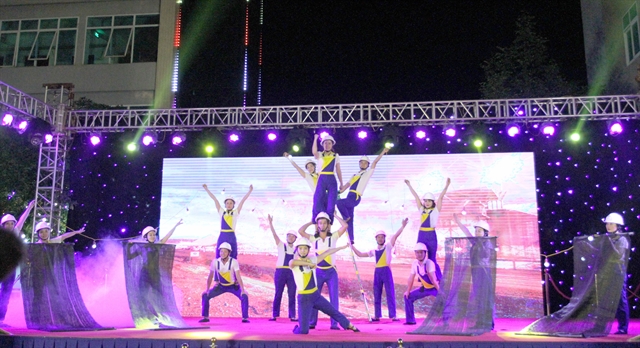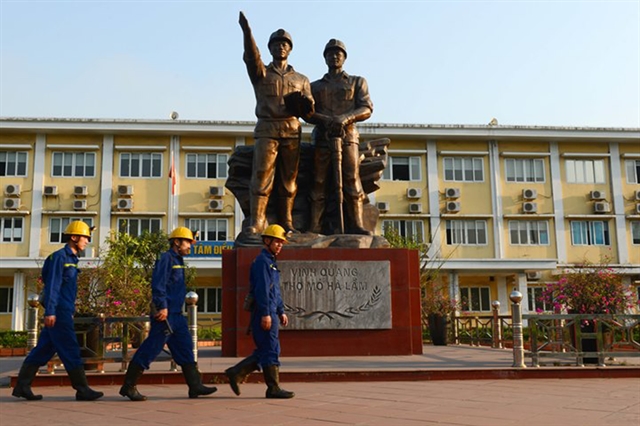
Mining workers of the Vàng Danh Coal Joint Stock Company show determination and solidarity before a work shift.

An art performance featuring the coal miners work at the Vàng Danh Coal Joint Stock Company. Photos baoquangninh.vn
Quảng Ninh Province is deeply proud of its coal miners and mining industry, which forms a great part of its historical and cultural identity.
Miners have their own unique characteristics and have become one of the foundations for building the culture and image of the province.

Many experts say 'discipline and consensus' (D&C) is the most complete and focused expression of the revolutionary and fighting spirit of Quảng Ninh mining workers.
Cultural researchers believe that the richness, diversity, and colour of the mining culture is due to the "magical interference" between many regional cultures, according to a local coal-mining official Bùi Khắc Trực.
Quảng Ninh is a land of different migrants from across the country, who come to settle down and do business since the French colonial times, such as those from the Red River Delta and the central provinces of Nghệ An and Hà Tĩnh, Trực said.
He revealed that such migrants, through their studying and hard work, have gradually become skilled miners mastering effective production to enrich themselves and the community,
Miners who come from other provinces and cities live in harmony with locals creating a special cultural melting pot. They form multi-generational mining families, villages, and crowded mining streets with their own customs.
"Among mining workers' intangible cultural values, the core value is a spirit of 'discipline and consensus'," Trực said.
Many experts say 'discipline and consensus' is the most expression of the revolutionary and fighting spirit of Quảng Ninh mining workers. The slogan reflects their unique methods in gathering and creating the robust strength of the mining work forces.

Miners perform deep drills into layers of 'black gold'. Photo baoquangninh.vn
This ideal has become a tradition and has been demonstrated by generations of miners in multiple aspects of life and in production. It was also reflected in history and in the revolutionary struggle for national independence and defence, as well as in social activities, and cultural and sports events.
Cradle of Vietnamese working class
“My father often tells me that the spirit of coal mining is in the blood of every mining worker. No matter how much life changes, each miner's love and attachment to the coal land remains unchanged. Therefore, we must not only work with a sense of responsibility but also with gratitude, enthusiasm and determination," Nguyễn Duy Khánh, a young miner in a family with three generations working as miners, said.
That tradition has accompanied the mining working class and the people of Quảng Ninh throughout history to enrich the country. It has been actualised as a material strength for the province to succeed in numerous fields.
A workshop about Quảng Ninh and its culture and human values took place in Uông Bí Town recently. It attracted more than 200 participants, including scientists, researchers and authority officials from provinces and cities who are interested in Quảng Ninh and its coal mining industry.
Quảng Ninh has a unique identity and is regarded as a cradle of the Vietnamese working class. The mining workers' traditions have been formed into a historical heritage and become a typical characteristic of the region.
Along with a profound mining tradition, a system of tangible and intangible culture, rich in identity and humanity has been established in Quảng Ninh over the past 60 years.
The province is the largest coal mining region in Việt Nam and is full of precious natural and cultural heritage, both natural and man-made.
Some 637 historical and cultural heritage sites and scenic spots, as well as over 2,800 intangible cultural heritage activities are present in the province, including customs, folk games and festivals.
In particular, the province is preserving six special national heritage sites, 58 national heritage sites, and 82 provincial heritage sites.
The "mining worker culture" that was formed and has been developed here for nearly 150 years, has been much honoured and is often associated with the revolutionary struggle for national independence.
The culture of the region is a combination of two elements, traditional cultural features and modern culture, both making Quảng Ninh's cultural heritage richer and more diverse.
To preserve its cultural values, the province has paid great attention to repairing and embellishing historical, cultural, and revolutionary heritage sites.
In the past five years, 10 per cent of national heritage sites and 70 per cent of provincial heritage sites have been repaired, restored and prevented from degradation. In addition, the province has conducted an inventory of seven types of intangible cultural heritage and carried out many programmes and projects.
The province's proud coal mining history is a major part of the region's culture, identity and traditions, and has inspired many typical products in efforts to attract tourists, as well as to improve the cultural and spiritual life of the locals. VNS
OVietnam